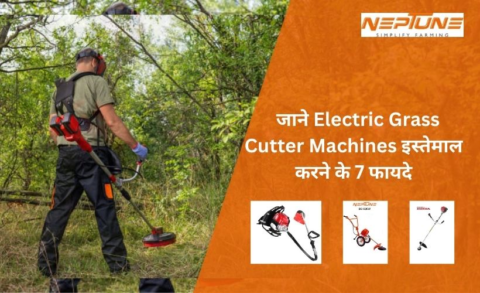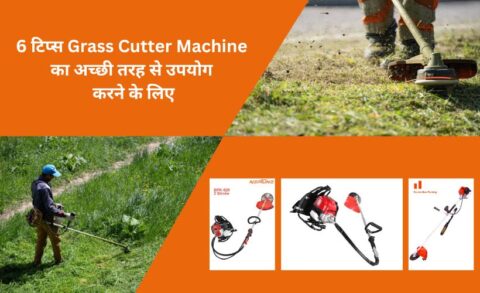An electric brush cutter machine is a powerful tool designed to clear dense vegetation, weeds, and small saplings that a regular lawnmower or trimmer cannot handle. This modern farming tool combines efficiency, precision, and ease of use, making it a must-have for both agricultural and gardening tasks.
What is an Electric Brush Cutter Machine and How Does It Work
An electric brush cutter consists of three main parts:
- Power Unit: An electric motor powered by either a cord or rechargeable battery.
- Shaft or Pole: A long extension that connects the motor to the cutting head.
- Cutting Head: Typically equipped with heavy-duty metal or specialized plastic blades that rotate at high speed.
Unlike a string trimmer that uses nylon line, the brush cutter’s robust blade easily slices through thick weeds and small shrubs. Operators hold the machine with ergonomically designed handles—either “bike handlebar” style or “D-shaped”—to guide the blade and cut vegetation effectively.
For generations, Indian farmers relied on the sickle—a labor-intensive and time-consuming tool. The electric brush cutter has revolutionized this process by offering:
1. Increased Efficiency and Productivity
A single operator can clear large areas of land in a fraction of the time compared to using a sickle. This speed is especially critical for tasks like land preparation, clearing weeds, and maintaining irrigation channels.
2. Versatility
Many brush cutters are multi-purpose. With interchangeable cutting heads, they can trim grass, cut weeds, and even harvest crops like paddy or wheat, making them a flexible solution for different farm needs.
3. Reduced Physical Strain
Traditional cutting methods are exhausting. Electric brush cutters come with ergonomic handles and harnesses that evenly distribute weight, allowing longer working hours with less fatigue.
4. Eco-Friendly Operation
Compared to petrol models, electric versions produce no emissions and operate much more quietly. This makes them environmentally friendly while also reducing noise pollution.
The factors that you should consider while buying the best lawn grass cutting machine in india
Choosing the right grass cutter machine requires evaluating your specific needs. Here are key factors to consider:
1. Power Source and Motor Capacity
- Corded Models: Unlimited runtime but limited mobility.
- Battery-Powered Models: Offer freedom of movement but check voltage (V) and battery capacity (Ah) to ensure adequate runtime and power.
2. Cutting Head and Blade Type
- Nylon Heads: Suitable for light trimming.
- Metal Blades: Required for thick weeds, grass, and shrubs.
Choose a model that supports multiple cutting heads for versatility.
3. Weight and Ergonomics
A lightweight design with comfortable handles and a supportive harness reduces operator fatigue and allows longer, more efficient work sessions.
4. Durability and Build Quality
Look for a sturdy machine built to withstand tough farm conditions. Ensure that the shaft, motor housing, and blade assembly are durable for long-term use.
5. Budget and Maintenance
Electric cutters usually cost less to maintain than petrol models, as they don’t require fuel, oil, or regular engine servicing. Compare models based on price, warranty, and the availability of after-sales service in your area before you buy grass cutting machine equipment.
Final Thoughts
The electric brush cutter machine has become an indispensable tool for farmers, gardeners, and landowners. It offers speed, versatility, comfort, and eco-friendly operation all crucial benefits in today’s farming landscape. Whether you’re maintaining a garden or preparing farmland, the right brush cutter will save time, reduce effort, and improve overall productivity.
Frequently Asked Questions (FAQs)
Q1: How long does the battery last on a cordless brush cutter, and what affects its run time?
Answer:
- Battery life depends on voltage, battery capacity (Ah), and how much load the cutter is under. Higher‐watt motors or cutting thick vegetation drains battery faster.
- On average, a good cordless electric brush cutter offers 30-60 minutes of continuous use per charge for light to moderate tasks. Heavier work will reduce that time.
- Also, charging time, battery type (lithium‐ion vs others), and how well batteries are maintained impact overall usable runtime.
Q2: Can I safely use an electric brush cutter for thick weeds, small bushes or rough terrain?
Answer:
- Yes, many electric brush cutters (especially battery-powered or corded heavy duty) can cut through thick weeds and small bushes, but performance depends on the power output (wattage), blade type, and design.
- For rough terrain or tougher vegetation, choose models with strong blades, safety guards, and good ergonomic designs so you can handle the strain.
- Be sure to use proper protective gear, keep a firm grip, and avoid overworking the motor to prevent overheating or damage.
Q3: What maintenance is needed to keep a grass cutter machine working well and extend its lifespan?
Answer:
- Regular cleaning: remove debris, grass clippings, and dirt from the blade, cutting head, and motor housing after each use.
- Blade / cutting head care: sharpen or replace dull blades; check for damage.
- Battery (if cordless): store properly, avoid deep discharge, keep terminals clean.
- Check fasteners, handle grips, straps make sure nothing is loose or worn.
- Store the machine dry, protected from moisture, and follow any manufacturer recommendations (e.g. lubrication, periodic servicing).










